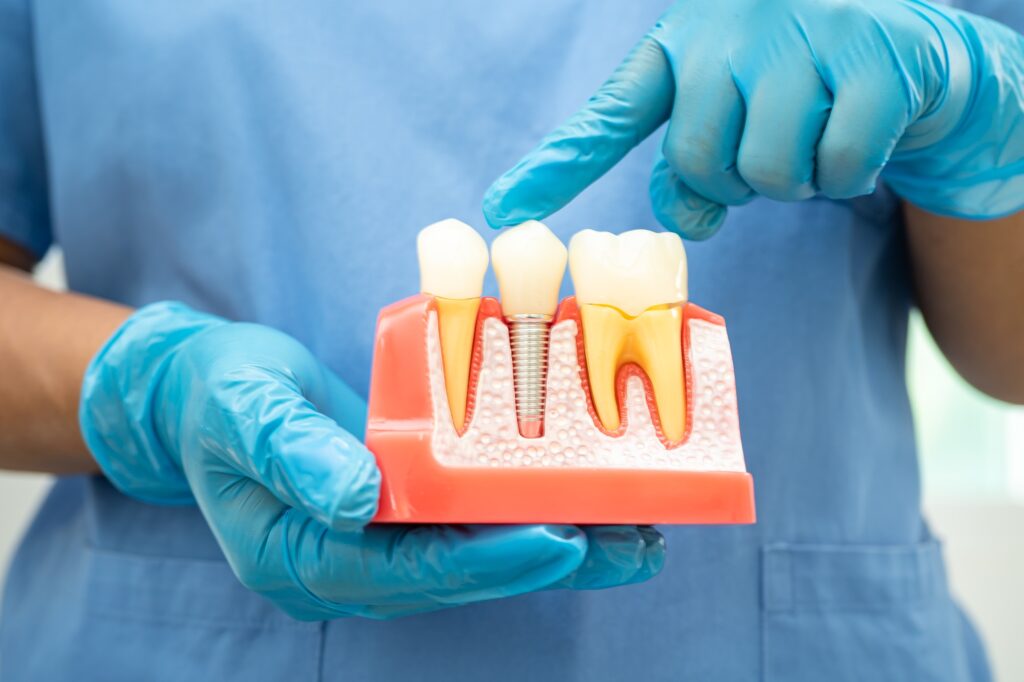Dental Bone Graft at Oxford Family Dental
A dental bone graft is a procedure used to replace missing or lost bone in your jaw. Bone grafting is commonly performed before dental implant surgery or when bone loss negatively impacts your oral health. This bone grafting surgery involves placing grafting material to rebuild jawbone structure. The initial healing process typically takes about a week, but full bone grafting recovery time may take up to a year. Our bone grafting dentist team ensures bone grafting procedures are safe and comfortable.

What is a Dental Bone Graft?
A dental bone graft is a surgical procedure designed to increase the density and volume of your jawbone. This process involves placing a grafting material, which may be natural or lab-made, in areas where bone has been lost. The bone graft serves as a scaffold, providing space for your body to regenerate and grow new bone tissue.
Types of Dental Bone Grafting Materials:
- Allograft: Bone sourced from a human donor, processed and sterilized by a licensed tissue bank.
- Alloplast: A lab-made material, such as hydroxyapatite, that mimics natural bone.
- Autogenous: Bone taken from another part of your own body, typically from the chin, hip, or another area.
- Xenograft: Bone derived from animal sources, usually from cows (bovine) or pigs (porcine), and processed by a licensed tissue bank.
When is a Dental Bone Graft Recommended?
Dental bone grafts are used to address various oral health concerns, including:
- Filling a tooth socket after extraction: Rebuilding the bone structure in areas where teeth have been removed.
- Increasing jawbone volume: Strengthening areas with insufficient bone for implants or other dental procedures.
- Preparing for dental implants: Ensuring your jawbone is strong enough to support implants.
- Rebuilding after dental trauma: Restoring bone damaged from accidents or injury.
- Treating bone loss from gum disease: Repairing damage caused by infections like periodontitis.
- Supporting loose teeth: Stabilizing teeth that are loose due to bone loss.
The Procedure for Dental Bone Grafting
During the dental bone grafting procedure, your dentist will:
- Numb the area with local anesthesia or administer sedation if necessary.
- Make an incision in your gums to expose the underlying bone.
- Clean and disinfect the area to prevent infection.
- Add the bone grafting material to the site of bone loss.
- Cover the graft with a protective membrane to promote healing. Some membranes dissolve naturally, while others may require removal during follow-up visits.
- Close the incision with stitches.
In some cases, your dentist may also use platelet-rich plasma (PRP) to promote healing. PRP is derived from a sample of your own blood and can accelerate tissue regeneration.
Pain and Recovery
Dental bone grafting is generally well-tolerated, and many patients report minimal discomfort. Post-procedure swelling and tenderness are normal but can be managed with prescribed pain relievers. Full recovery may take a few weeks, and it may take several months for the bone to fully integrate with the graft.
Risks and Benefits
Benefits:
- Restores jawbone structure and density, improving eligibility for dental implants and other restorative treatments.
- Helps prevent further oral health issues such as tooth loss, difficulty chewing, and facial changes due to bone loss.
Risks:
- As with any surgical procedure, there are some risks, including:
- Infection
- Nerve damage
- Bleeding
- Swelling
- Bone graft failure (though rare)
Failure is more common among smokers or those with certain medical conditions, and signs of failure include increased pain or swelling, lack of improvement in jawbone volume, or infection.
Recovery and Aftercare
After the procedure, follow these tips for a smooth recovery:
- Rest and avoid strenuous physical activity for at least 48 hours.
- Apply ice packs to your jaw to reduce swelling.
- Eat soft foods like yogurt, mashed potatoes, and smoothies for a few days.
- Keep the surgical site clean but avoid brushing directly on it until your dentist advises otherwise.
- Take medications as prescribed, including pain relievers and antibiotics, to prevent infection.
How Long Does a Dental Bone Graft Last?
Once the bone graft has healed, it can last a lifetime. However, if the graft is intended for use with dental implants, it’s important to have the implants placed within six to twelve months after the graft heals. Delaying this can cause the graft to shrink and lose density over time.
When to Call Oxford Family Dental
If you experience any of the following after a dental bone graft, contact Oxford Family Dental:
- Fever over 101°F (38.3°C)
- Increased swelling or redness around the surgical site
- Pus or unusual drainage
- Severe pain that doesn’t improve with pain medication
Dental bone grafting is a highly effective procedure that helps restore your oral health and prepares your jaw for further treatments like dental implants. If you’re considering a dental bone graft or need more information, our team at Oxford Family Dental is here to guide you through every step of the process. Contact us today to schedule a consultation!



